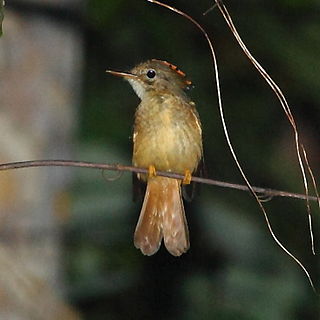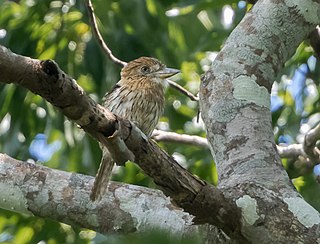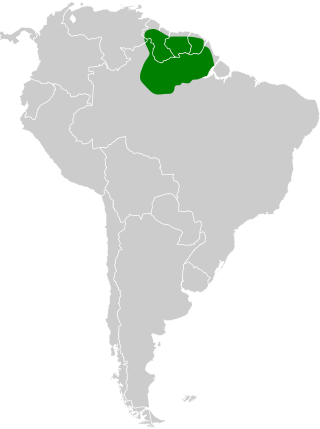
The Iquitos gnatcatcher is a bird in the family Polioptilidae. It was first described in 2005. It is known only from the Allpahuayo-Mishana National Reserve, west of Iquitos, Peru.

The royal flycatchers are a genus, Onychorhynchus, of passerine birds that the International Ornithological Committee (IOC) places in the family Tityridae.

The eastern striolated puffbird is a species of bird in the family Bucconidae, the puffbirds, nunlets, and nunbirds. It is found in Bolivia and Brazil.
Anurolimnas is a genus of birds that the South American Classification Committee of the American Ornithological Society and the Clements taxonomy apply to the chestnut-headed crake, the russet-crowned crake, and the black-banded crake. The International Ornithological Committee assigns the first two species to genus Rufirallus and the black-banded to genus Laterallus. BirdLife International's Handbook of the Birds of the World also places the first two in Rufirallus but assigns the black-banded to genus Porzana.

Brigida's woodcreeper, also known as the Mato Grosso woodcreeper, is a subspecies of bird in the subfamily Dendrocolaptinae of the ovenbird family Furnariidae. It is endemic to Brazil.

The tawny-faced gnatwren or half-collared gnatwren is a species of bird in the family Polioptilidae, the gnatcatchers. It is found in Bolivia, Colombia, Costa Rica, Ecuador, Nicaragua, Panama, and Peru.

The collared gnatwren is a species of bird in the family Polioptilidae, the gnatcatchers. It is found in Brazil, Colombia, Ecuador, French Guiana, Guyana, Peru, Suriname, and Venezuela.

Polioptila is a genus of small insectivorous birds in the family Polioptilidae. They are found in North and South America.

The Guianan gnatcatcher is a species of bird in the family Polioptilidae. It is found in Brazil, French Guiana, Guyana, Suriname, and Venezuela.

The white-browed gnatcatcher is a species of bird in the gnatcatcher family Polioptilidae. It is native to central and South America.

The Amazonian trogon, is a species of bird in the family Trogonidae, the trogons and quetzals. It is found in Bolivia, Brazil, Colombia, Ecuador, Peru, and Venezuela.
The Sinú parakeet is a bird in subfamily Arinae of the family Psittacidae, the African and New World parrots. BirdLife International's Handbook of the Birds of the World recognizes it as a full species. The International Ornithological Committee (IOC), the South American Classification Committee of the American Ornithological Society, and the Clements taxonomy treat it as a subspecies of the painted parakeet.

The black-throated toucanet is a near-passerine bird in the toucan family Ramphastidae. It is found in Bolivia, Brazil, Ecuador, and Peru.

The black-legged parrot, also known as the western white-bellied parrot, is a bird in subfamily Arinae of the family Psittacidae, the African and New World parrots. It is found in Bolivia, Brazil, and Peru. The South American Classification Committee of the American Ornithological Society, the International Ornithological Committee, and the Clements taxonomy treat the black-legged parrot as a subspecies of the white-bellied parrot. BirdLife International's Handbook of the Birds of the World (HBW) considers it a full species.

The yellow-tailed parrot, also known as the central white-bellied parrot, is a bird in subfamily Arinae of the family Psittacidae, the African and New World parrots. It is endemic to Brazil. The South American Classification Committee of the American Ornithological Society, the International Ornithological Committee, and the Clements taxonomy treat the yellow-tailed parrot as a subspecies of the white-bellied parrot. BirdLife International's Handbook of the Birds of the World (HBW) considers it a full species. It is rare in captivity in comparison to other taxa of the genus.

The white-throated toucanet or greyish-throated toucanet is a near-passerine bird in the toucan family Ramphastidae. It is found in Colombia, Ecuador, and Venezuela.

The Rio Negro gnatcatcher is a species of bird in the family Polioptilidae. It is endemic to Brazil.

The Para gnatcatcher or Klages's gnatcatcher, is a species of bird in the family Polioptilidae. It is endemic to Brazil.

The chattering gnatwren is a species of bird in the family Polioptilidae, the gnatcatchers. It is found in Bolivia, Brazil, and Peru.


















